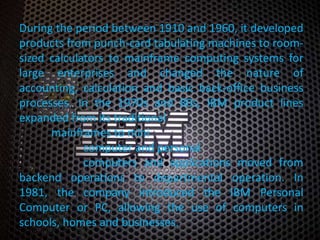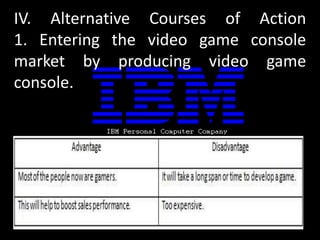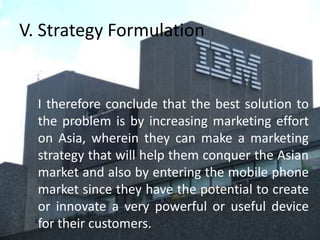Ibm
- 1. Introduction: Brief History of IBM
- 2. In 1886 Herman Hollerith, a statistician for the US Bureau of Census formed the Tabulating Machine Company and Thomas J. Watson became its leader in 1915 and made the company slogan “Think”. It changed its name to International Business Machines (IBM) in 1924. It was taken by the US government at the beginning of World War II in the war effort and given a one percent profit, which it used to fund war victims and orphans.
- 3. During the period between 1910 and 1960, it developed products from punch-card tabulating machines to room- sized calculators to mainframe computing systems for large enterprises and changed the nature of accounting, calculation and basic back-office business processes. In the 1970s and 80s, IBM product lines expanded from its traditional mainframes to mini computer and personal computers and applications moved from backend operations to departmental operation. In 1981, the company introduced the IBM Personal Computer or PC, allowing the use of computers in schools, homes and businesses.
- 4. Components for the computer were sourced from outside the company. The processor chip came from Intel and the operating system, called DOS (Disk Operating System), came from Microsoft.IBM introduced the ThinkPad in 1992, the first in a series of notebook computers to be manufactured by the company. In 1995, IBM acquired Lotus Development Corporation and Tivoli Systems. In 1997, IBM demonstrated computing’s potential with Deep Blue, a 32-nodeIBM RS/6000 SP computer programmed to play chess on a world class level. During the nineties, with the Internet and open standards, IBM embraced the network computing model and coined “e business” to describe how network computing can transform core businesses and transactions.
- 5. In October 2002, IBM acquired PwC Consulting, the global management consulting and technology services unit of Price Waterhouse Coopers. IBM sold most of its hard disk drive operations to Hitachi in December 2002. The sale involved the creation of a joint venture called Hitachi Global Storage Technologies, which was 70%- owned by Hitachi. In 2003, IBM Research launched On Demand Innovation services, which teamed customers with a team of researchers who specialize in business transformation and technology consulting. Over one billion will be spent over the next three years and will be staffed with200 IBM research consultants. Today, IBM is by far the largest information technology in the world and the eighth largest company in the world. In 2003, it had revenues of US $89.1 billion, a net income of 4.32, more than 366,000 employees in 170 countries with approximately sixty percent of revenues generated outside the United States.
- 6. Vision Breakthrough microprocessor architecture that puts broadband communications right on the chip. Mission At IBM, we strive to operate in the invention, development and manufacture of the industry's most advanced information technologies, including computer systems, software, storage systems and microelectronics.
- 7. Corporate Social Responsibility • Organizations today are embracing a more sustainable approach to business – one that takes into account the environmental and societal impact of their activities. By factoring this accountability into their strategy, they implement new ways to source, manufacture, and distribute goods in a more sustainable manner, often while simultaneously lowering costs. And, based on more transparent and proactive engagement with employees, consumers and the communities where they operate, organizations are becoming better equipped to create products and services for a smarter planet.
- 8. Values We translate these advanced technologies into value for our customers through our professional solutions, services and consulting businesses worldwide. STATEMENT OF THE OBJECTIVE To be able to find other way to increase profit especially in Asia. CENTRAL PROBLEM How to be able to increase their market share and profit.
- 9. PRODUCTS
- 10. PRODUCTS
- 11. S.W.O.T. Opprtunities: 1. Video game console market revenueis projected to reach $12 billion in2008 and $66 billion in 2012. 2. The IT market in Russia, India,Brazil, and China are expected togrow twice as fast as in the rest of the world. 3. Mobile phone markets are expectedto grow by 9% in 2008*. 4. Handheld computers markets areexpected to grow by 32% in 2008. THREATS: 1. Competitors are strong. 2. Economic fluctuation could crimp consumers’ spending. 3. Small & Medium business demands fail to accelerate.
- 12. STRENGHT: 1. IBM revenues increased 7 percent to69.92$.billion in 2006. 2. A unique approach to engage their employees in an online intranet using its Jam technology. 3.Strong strategic planning to be an innovation- centric globally integrated corporation. 4.IBM operates in 170 countries with about 60 percent of its revenues being generated outside the US. 5. IBM concentrated on becoming stronger in high value added businesses. 6. IBM ranked number 1 hosted service provider in Western Europe. 7. IBM is supercomputing leader as provider of 35 of the world's 100most powerful supercomputers.
- 13. WEAKNESS: 1. Declining in revenues of services and systems segments in 2006. 2. Decline in revenue of public, industrial, small and medium business industries in 2006 by 9.6%. 3. Decline in revenues in Asia Pacific area by 5.7%. 4. Total assets are gradually decreasing from 109M to103M in 2006.
- 14. IV. Alternative Courses of Action 1. Entering the video game console market by producing video game console.
- 15. 2. Entering the mobile phone market.
- 16. 3. Increasing marketing efforts into Asia Pacific.
- 17. V. Strategy Formulation I therefore conclude that the best solution to the problem is by increasing marketing effort on Asia, wherein they can make a marketing strategy that will help them conquer the Asian market and also by entering the mobile phone market since they have the potential to create or innovate a very powerful or useful device for their customers.
- 18. VI. Plan of Action 1. Making use of local celebrities on Asia to get the attention of possible target markets. 2. Finding Tie-up or X-deals to other related establishments on Asia that will help them promote their products. 3. Creating a new Operating system that will make their phone far different to other phones.
- 19. VII. Potential Problem 1. What if the artist is not effective? 2. What if this establishments wasn’t able to promote your product consistently and accurately? 3. What if the new Operating system did not meet the target markets expectations?
- 20. VIII. Contingency Plan 1. They can also use other personalities that most of the Asian people believe in, like Politicians and popular people on their country. 2. They can hire people from that country to be trained about their products to be able to promote it consistently and accurately. 3. They should make an update for their operating system through the feedback of their customers with a certain products. And they can also use a free Operating System that is stable and has a good impressions or feedback today.



















